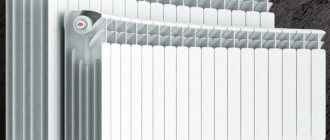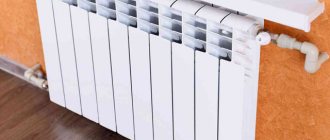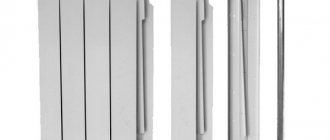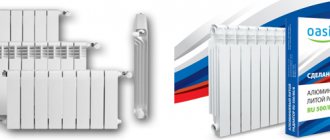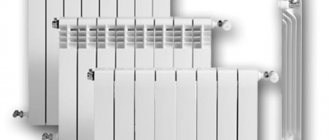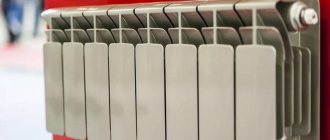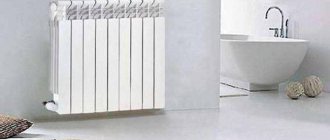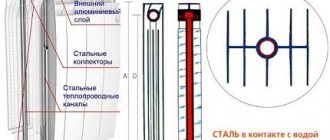When deciding to change the heating system or installing it in a new home, you need to take the choice of radiators seriously. They must fully provide heating in the rooms and fit perfectly into the interior of the rooms. Today, many different types of batteries are produced, from which you need to choose the ones that are suitable for your home. One of them is bimetallic heating radiators from the Rifar company.
Bimetallic heating radiators Rifar
Batteries must be selected according to certain parameters and characteristics. It is worth taking a closer look at these products and, of course, learning a little about their manufacturer.
ABOUT
The Russian one has been operating since 2002. During this time, it developed and adapted for sale modern heating radiators, which are used with great success throughout Russia and the CIS countries.
Not only Russian, but also foreign specialists and designers took part in the development of these products. The developments were aimed at creating a high-tech, economical and modern product that should not be inferior to European analogues. In addition, the Rifar batteries had to take into account the peculiarities of local climatic conditions and the requirements for functioning in Russian heating systems.
The production process of Rifar radiators
The result of the work is high-quality products with excellent characteristics, which are in great demand, growing from year to year.
Domestic radiators are reliable and fully justify the warranty period established by the manufacturer when operating in circuits connected to centralized heating. This is evidenced by numerous reviews from those who have installed such batteries in their apartment. There are practically no cases of complaints.
User reviews
People have differing opinions regarding the use of batteries. Most users note that during normal operation of the heating system no difficulties are observed. The equipment does not leak, does not wear out prematurely, and is easy to clean and free of dust. The radiators do not protrude beyond the window sill and fit harmoniously into the interior.
Customers will be pleased with a solid line of models suitable for use in the harsh Russian climate. The equipment can be operated even if the thermal fluid does not meet the regulatory parameters, which is not uncommon in domestic realities. Each radiator of the Russian company Rifar successfully copes with this task, providing comfort in your apartments.
Radiator characteristics
Bimetallic heating radiators "Rifar" are intended for installation and use both in administrative buildings and in residential premises of houses and apartments. They are designed specifically for the local heating system with a certain pressure and coolant.
- The products are made of two metals - the inside of the coolant tanks is made of steel, and the body is made of aluminum. The case is the “face” of the product and gives the batteries neatness and elegance, since the panels have an enamel coating on top.
- The internal cavities for moving coolant are quite reliable and can easily withstand pressure of 30-40 atmospheres. And aluminum, in itself, is an excellent conductor of heat; when heated by steel parts, it transfers thermal energy well into rooms.
- When operating such radiators in an autonomous system, a large amount of coolant is not required - only 0.2 liters are needed for one section. Therefore, the circuit heats up very quickly, and it is quite possible to save money on heating large rooms. This parameter of batteries can easily be attributed to their positive qualities.
- The steel parts of Rifar radiators can easily withstand temperatures up to 130 degrees.
- Thermal output from each section is 180-200 W.
Disadvantages of centralized heating supply
It is necessary to take into account the operating features of the central heating system that are unfavorable for radiators. Typically, residents of apartment buildings may encounter the following difficulties:
- Chemically active coolant. There are many impurities in the water that circulates in the system. They can corrode the walls of radiators inside and cause corrosive processes.
- Solid fragments in water. The smallest solid particles in the coolant act as abrasives. They can scratch and wear through the metal of the device. Devices must be made of reliable, stable and durable material.
- Unstable temperature readings. The operation of the central heating system is not always stable. At one time the batteries heat up weakly, at others they heat up too much. Heating devices in a home must operate effectively over a wide temperature range.
- Unstable pressure. Sudden pressure changes in heating systems are called water hammer. They can significantly damage radiators and compromise the integrity of the product body. In the process of selecting products for an apartment, emphasis should be placed on the design pressure, which is indicated in the documentation.
Types of radiators
Radiators come in a variety of sizes
Different radiator models also have their own characteristics, and differ mainly in their dimensions and center distance. The size of the battery, in addition, directly affects its heat dissipation. To familiarize yourself with the specific parameters of various models, you can look at the table compiled by the manufacturer.
| Model | Center distance in mm. | Depth in mm. | Height in mm. | Width in mm. | Weight of each section. | Heat flow rating of one section in W. |
| Base 500 | 500 | 100 | 570 | 79 | 1,92 | 204 |
| Base 350 | 350 | 90 | 415 | 79 | 1,36 | 136 |
| Base 200 | 200 | 100 | 261 | 79 | 1,02 | 104 |
| Alp 500 | 500 | 75 | 570 | 79 | 1,50 | 191 |
So, the center distance affects the dimensions of the battery. For example, “B-200” is well suited for a small room, and “B-500” will look great in a room with a large area. If the square footage of the room is large, and even with large window openings, then to heat it you need to purchase the “A-500” model, which has excellent heat transfer.
Models are also divided according to their connection type. Some of them have special pipes for lower connections, and they can easily be installed in an already installed heating circuit. The cost of these radiators is slightly higher than with a conventional insert system. But it should be noted that these models have much more advantages, both from a technical and aesthetic point of view.
Bottom connection diagram for Rifar radiators
So, the advantages of such Rifar radiators:
- The aesthetics of the bottom connection is that all pipes run along the floor and do not rise above the baseboard.
- Easy and quick installation - installation will not take much time and effort, and for the Rifar-monolith model you will not even need valves to connect the sections, which will allow you to save money.
- Each radiator model is patented and has a technical passport.
- Radiators with outlets for connection from below are suitable for any coolant, including antifreeze.
- The built-in thermostat allows you to control and set the temperature in the battery as required at the moment.
Possibility of precise adjustment of heating temperature
- Due to the increase in product output and the filling of the market, the manufacturer annually reduces prices for its products, giving the opportunity to more and more people to purchase such high-quality equipment for their homes.
Installation recommendations
Any heating equipment has serious requirements in terms of installation location. If you follow the tips and recommendations, the installed battery will effectively heat the room without heat loss.
The location for mounting devices is the most important issue. The best option is under the window. In this way, possible heat loss is leveled out, and condensation does not form on the windows.
Installation distances:
- from the window sill to the top edge of the battery - 15 cm;
- from the wall – 5 cm;
- from the floor – 15 cm.
If the connection was made incorrectly, then about 40% of the heat will be “lost”.
The installation algorithm is as follows:
- The places where the brackets will be fixed are marked on the wall.
- Fastenings are installed on a brick or concrete wall using dowels. If the partition is made of plasterboard, the fastening must be double-sided.
- Installing the radiator on the brackets.
- Connection with pipes.
- Connecting a thermostatic valve or faucet.
- Air valve installation.
You can do the installation yourself, but if the skills are not enough, it is better to entrust this task to specialists.
When installing yourself, you must adhere to the following recommendations:
- Before starting work, you need to turn off the water supply. It should not remain in the pipes.
- Check the equipment set. Typically, radiators are supplied ready for installation; otherwise, assembly is carried out according to the included instructions.
- For bimetallic batteries, right- and left-handed threads are provided, which must be remembered when tightening the elements.
- When connecting fittings, you need to use a suitable material. Flax with a sealant that is resistant to high temperatures is suitable.
- You should have a prepared connection diagram at hand. It can be side, bottom and diagonal.
- Having completed the installation, you can smoothly open the taps, releasing coolant into the system. Next, the remaining air is released from it using a special tap.
- It is not recommended to install screens over radiators because this will reduce the heating efficiency.
Modern heating devices are so lightweight compared to traditional cast iron products that installation work can be done by one person. Read about the automatic coal boiler on our website.
Design of Rifar heating radiators
It deserves special attention that such a battery can be used not only as a heating device. In order for the radiator to also serve as a dryer, you can purchase an additional element that is installed on the ribs of the outer sections. Of course, you can’t hang something heavy on such a dryer, but such a bracket will easily hold a towel.
Convenient towel drying rack
Rifar batteries vary in size and can be straight or slightly curved. They always have a white enamel base coat.
Interesting arc-shaped battery
Many homeowners want to see something special and exclusive in their home, and therefore some refuse such a convenient and reliable type of radiators in favor of those that have a variety of colors. If this is only the case, then the problem can be easily solved, but you just need to remember that exclusivity costs separate additional payments. But what can’t you do to create harmony in your home?
Recently, decorating the flat surfaces of radiators has become increasingly popular. This is done using photo printing, which is done by some photo studios. The photo decoration technique allows you to decorate Rifar radiators in each room in its own way, according to the interior design.
Example of radiators with photo printing
For example, this option can be placed both in the living room and in the bedroom. This radiator can quite claim to be a decorative element adorning the room, which will stand out as a bright spot against a properly thought-out background. It will definitely attract the eye and arouse the admiration of guests. Looking at this piece of furniture, you don’t even immediately understand that this is just an element of the heating system - so it fits successfully and organically into the interior.
Some people prefer a seascape
Another decoration not only for the battery, but also for the entire design of the room, can be a photo with a sea or other landscape chosen to your taste. The main thing in this case is to maintain the correct combination of the shade of the wall and the objects surrounding the radiator.
An alternative to photo printing for the design of the Rifar battery can be a glass screen. There is no need to be afraid that this decorative device will block the heat flowing into the room - this will not happen, since the panels are designed in such a way that they do not interfere with the radiators performing their direct function.
Radiators with glass screen
These screens are available in either a single color or with a specific pattern. They are especially convenient for the kitchen, as they will not allow grease and fumes to settle on the battery. The screens are easily dismantled, so you can simply remove them if you are tired of them, or in order to wash them thoroughly.
Calculation of heating batteries per room
The number of products can be determined only after calculating the required number of sectional elements. Next, you need to decide how many devices you will install. In our example, it turned out that one should have 10 sectional parts. This can be a whole product installed under the window. For a corner room, it is better to divide this number in half or into 4 and 6 parts and mount a device at each outer wall. Another option is to calculate the heat value required to heat the room:
- For our example, it is – 100*16 = 1600 W or 1.6 kW.
- Next, select a specific product and determine its heat transfer by multiplying the characteristic of one element with the same name by their number. For example, let's take a 6-section model with an indicator of 180 W for one part - 6 * 180 = 1080 W.
- Divide the required heat value by the power of the entire device - 1600/1080 = 1.48. We round this value up. As a result of the calculations, we obtain a quantity equal to 2.
Helpful tips when choosing
To choose the right Rifar radiator based on its operational parameters and appearance, you need to know important nuances:
- Bimetallic radiators are very similar in appearance to aluminum radiators, as they have the same shape and color. However, they differ greatly in price. The cost of aluminum batteries is much lower than bimetallic ones, since they are inferior in quality, service life and have limitations in operation.
- It is imperative to take into account the area and volume of the heated rooms - this is necessary in order to choose the most effective size and parameters of the batteries, and not overpay extra money.
Delivery
Delivery within the city: from 350 rub. , November 28
Delivery to the regions: from Moscow
Gross weight of goods: 26.39
kg
Dimensions in packaging, mm: 960
x
110
x
600
In which city do you want to receive the goods?
select cityAbakanAdlerAksaiAktauAktobeAlexandrovAlmatyAlmetyevskAnadyrAnapaAngarskArmavirArtemArkhangelskAstanaAstrakhanAtyrauAkhtubinskAchinskBaiserkeBakuBalakovoBalashovBalezinoBalkhashBaranovichiBarnaulBatayskBelgorodBelogorskBelokurikhaBeloyarskyBerezniki BiyskBirobidzhanBlagoveshchenskBobruiskBodayboBorBorisoglebskBratskBrestBryanskBugulmaBuguruslanBudenovskBuzulukVeliky NovgorodVitebskVladivostokVladikavkazVladimirVolgogradVolgodonskVolzhskVolzhskyVologdaVolskVorkutaVoronezhVoskresenskVyborgVyksaVyshny VolochekV YazmaVyatskie PolyanyGlazovGomelGorno-AltaiskGrodnoGroznyMudGubkinGubkinskyDalnegorskDerbentDzerzhinskDimitrovgradDonetskFriendlyDudinkaEvpatoriaEgoryevskEkaterinburgEletsEssentukiZhezkazganZheleznodorozhnyZabaikalskZelenodolskZlatoustZubovoIvanovoIgnatovo ZhevskIntaIrkutskIshimYoshkar-OlaKazanKaliningradKalugaKamensk-UralskyKamensk-ShakhtinskyKamen-on-ObiKanashKanskKaragandaKarasukKemerovoKerchKizlyarKineshmaKirovKiselevskKlinKlintsyKogalymKokshetauKolomnaKolpashevoKomsomolsk-on-AKomsomolsk-on-AmurKostanay KostromaKotlasKrasnovisherskKrasnodarKrasnoyarskKropotkinKuznetskKuibyshevKumertauKurganKurskKyzylKyzylordaLabinskLabytnangiLagovskoyeLangepasLeninsk-KuznetskyLesosibirskLidaLipetskLiskiLyubertsyLudinovoMagadanMagasMagnitogorskMaykopMalye KabanyMakhachkala MezhdurechenskMiassMinskMirnyMikhailovkaMichurinskMogilevMoscowMuravlenkoMurmanskMuromNaberberezhnye ChelnyNadymNazranNalchikNaro-FominskNaryan-MarNakhodkaNevinnomysskNeryungriNeftekamskNizhnevartovskNizhnekamskNizhny NovgorodNizhny TagilNovaya CharaNovozybkovNovokuz NetskNovorossiyskNovosibirskNovosibirsk SouthNovocheboksarskNovocherkasskNovy UrengoyNoginskNorilskNoyabrskNurlatNyaganObninskOdintsovoOzerskOktyabrskyOmskOrelburgOrskPavlovoPavlodarPangodyPenzaPermPetrozavodskPetropavlovskPetropavlovsk-KaPetropavlovsk -KamchatskyPodolskPolotskPolyarnyPrigorodnoyeProkopyevskPskovPyatigorskRossoshRostov-on-DonRubtsovskRybinskRyazanSalavatSalekhardSamaraSt.PetersburgSaranskSarapulSaratovSevastopolSeverobaikalskSeverodvinskSeverskSemeySerpukhovSimferopolSlavyansk- na-KubanSmolenskSovietSoligorskSolikamskSorochinskSochiStavropolStary OskolSterlitamakSurgutSyzranSyktyvkarTaganrogTairovTaximoTaldykorganTambovTarazTashtagolTbilisiTverTikhoretskTobolskTogliattiTomskTuapseTulaTyumenUlan-UdeUlyanov SKURAIUralskUsinskUsolye-SibirskoyeUssuriyskUst-IlimskUst-KamenogorskUst-KutUst-LabinskUfaUkhtaFeodosiaKhabarovskKhanty-MansiyskKhasavyurtKhimkiTchaikovskyChelyabinskCheremkhovoCherepovetsCherkesskChitaChusovoySharyaShakhtyShymkentSchelkovo EkibastuzElektrostalElistaEngelsYugorskYuzhno-SakhalinskYakutskYaltaYalutorovskYamburgYaroslavl
Flex
The uniqueness of bimetallic radiators of this series lies in the possibility of imparting a certain curvature to the plane. This model is equipped with base series sections, but thanks to the bracket system it is possible to produce both convex and concave radiators.
The minimum bending radius is 1450 mm. To order radiators of this shape, you must specify the bending radius and direction. It is noteworthy that all technical parameters are preserved regardless of the form.
Types of aluminum batteries
Note! Aluminum radiators are produced by two methods - casting and extrusion. When using the casting method, each section is manufactured separately
The raw material is silumin - aluminum with silicon additives not exceeding 12%. Casting produces sections of various shapes that can withstand pressures of up to 16 atmospheres.
The extrusion method does not produce radiators, but their individual parts, which are then fastened together. This method makes it possible to reduce the cost of production, but in terms of technical characteristics, batteries created by extrusion are inferior to cast ones. They also have one more drawback - it is impossible to change the number of sections in the radiator.
It is impossible not to note another type of aluminum batteries - anodized type. They are the most expensive and, of course, high quality. The raw material for their production is purified aluminum. The finished product is anodized, making it completely corrosion-resistant. The individual parts in such radiators are connected by couplings.
Therefore, they are absolutely smooth inside, which means they are not afraid of scale accumulation. Their working pressure is up to 70 atmospheres.
Manufacturer's motto: reliability and quality
The Rifar company appeared in 2002, it is a Russian enterprise, its specialization is bimetallic heating radiators; ordinary aluminum ones are also produced, but they are produced by only one line. The main office is located in Moscow, and the factories themselves are located in the city of Gai , located in the Orenburg region.
The production is fully automated, high-tech furnaces and equipment were imported from Italy. The manufacturer cares about the consumer and values its own reputation, so it relies on the quality of its products, takes into account the shortcomings and improves the advantages.
